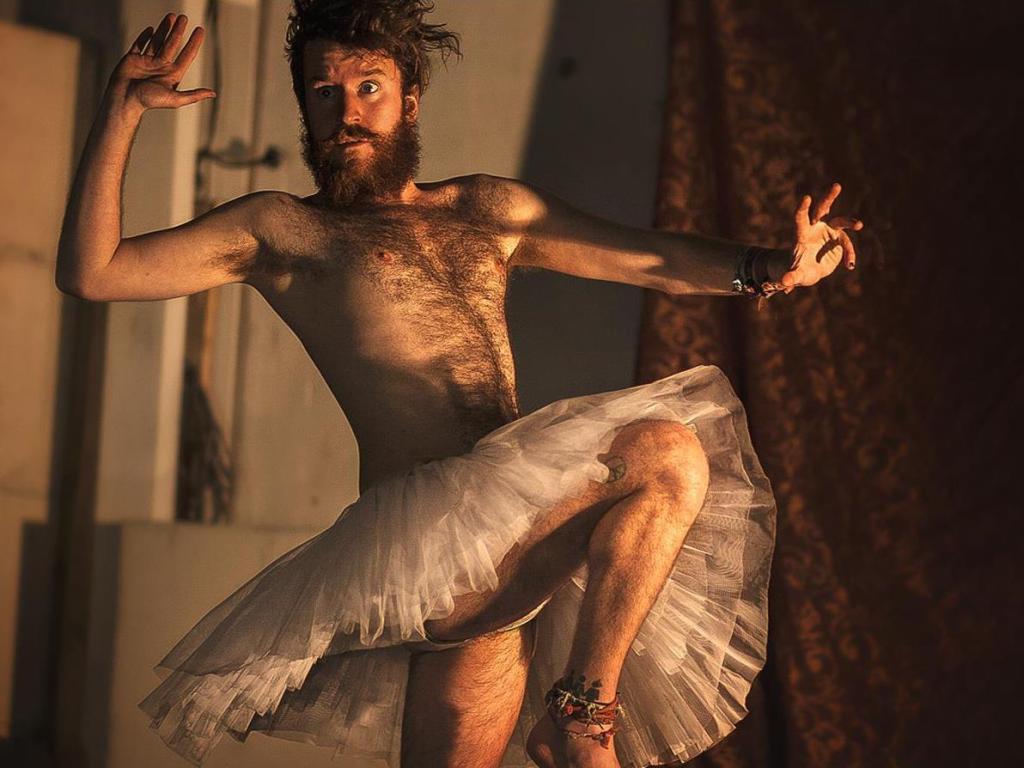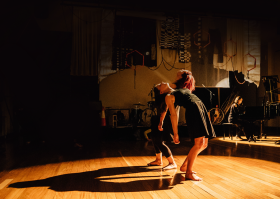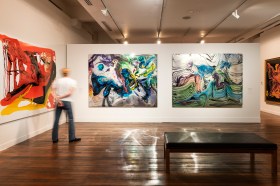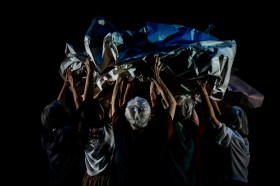Melbourne Fringe production F*#king with Gender, image supplied.
Now in its 33rd year, the Melbourne Fringe Festival – which predates Melbourne Festival by four years – this year features 401 separate shows presented by some 6000 artists: many of whom are participating in the festival for the first time. It’s the biggest Fringe ever in the festival’s history: a heartening sign given recent changes to the arts funding landscape.
‘It’s another enormous year for Melbourne Fringe, for a start; growth on the whole is definitely one of our trends,’ said Melbourne Fringe’s Felix Preval, Producer, Festival and Artist Services.
Preval sees the Festival’s consistent, sustained growth as a healthy sign for the independent arts generally.
‘Last year was the biggest Festival ever by about 30%; there was a 30% jump on 2013 … in terms of number of shows. So as Melbourne’s leading open-access multi-arts festival, I think Melbourne Fringe is a pretty important annual barometer of the vibrancy of the independent arts sector. And despite all of the funding crises that are happening, the independent sector is as strong as ever – if not stronger. And to sustain that level of growth for another year, to still be at 400-plus shows is pretty phenomenal,’ he said.
Running from 16 September to 4 October, Melbourne Fringe is not only indicative of the robust health of the independent arts in Australia; its program also reflects some of the wider themes and trends of interest to Australian artists.
The rise of cabaret
As previously noted by ArtsHub, cabaret is a growth area in the independent sector – though there are a range of suggestions as to why the art form has grown so rapidly. Some point to the increase in graduates from music theatre courses at our elite training institutions; others suggest that cabaret’s popularity is due to it being an art form that particularly resonates with the Australian psyche. Regardless, its popularity is also evident at Melbourne Fringe.
‘While comedy and theatre remain the backbone of the festival, vying for largest single category in the Guide, this year we’ve seen a big growth in cabaret,’ said Preval.
The cabaret category at this year’s Melbourne Fringe includes the return of established performers (including Helpmann Award winner Yana Alana with a new work, Covered, and Green Room Award winner Geraldine Quinn in MDMA: Modern Day Maiden Aunt) as well as a range of new talents.
‘It’s great to see a raft of new, emerging voices in the cabaret scene coming through, like Alice Tovey: Malice, and Little V’s Terrible Tea Party, the [former] very much along the lines of single female musical comedian genius, and the other in a broader theatrical context. They’re two concurrent areas of growth, so we’re very pleased about that.’
Disability arts
Another trend at this year’s Melbourne Fringe is the increased participation of artists with disabilities in a range of Fringe Festival categories. In comedy, New Zealander Thane Pullan performs stand-up from his wheelchair in The Grumpy Cripple Live. The performance category includes Deaf Slam Poetry, featuring visual poetry performed in sign language and visual vernacular for both deaf and hearing audiences; and Quippings: Disability Unleashed, an evening of subverted stereotypes described as ‘not suitable for children or do-gooders’.
‘We want the festival to be as accessible as possible – to both audiences and artists,’ said Preval. ‘It’s great to see more artists with disabilities taking part in the festival each year – we’re particularly excited to have Arts Access programming 10 days of workshops and activations in City Square in their Nebula caravan – it’s a really visible way to highlight the festival’s connection with an important part of the creative community.’
Gender, sex and death
‘At the core of every Melbourne Fringe you can find iterations on sex and death, but this is a particularly strong year, with a really interesting vein of new works around sexuality and gender,’ said Preval.
‘There’s a number of gender-queer artists, and artists who are really interested in navigating gender fluidity through performance that are quite present in the program; and I think that puts us in line with most other Fringe Festivals. Melbourne Fringe is a really important space for independent and emerging artists from the LGBTQI communities to present new and experimental ideas.’
Highlights here include FAG/STAG by Perth collective The Last Great Hunt, a deeply resonant and engaging exploration of friendship between two 20-something men, one gay, one straight; the immersive vaudeville performance F*#king with Gender, billed as ‘a dream play set inside the head of a genderless human being whose culture is driven by labels,’ and in cabaret, Jessica McKerlie’s Gender Spanner, exploring what it is to exist outside or between the traditional male/female dichotomy.
And then there’s the art of dying. As Preval puts it: ‘Death turns out to be a theme of the festival this year, for whatever reason. There are a lot of people talking about death … and the ways other cultures recognise the processes of death, and our preoccupations with dying.’
Fringe meditations on mortality include the cabaret Kick the Bucket by songwriter Melissa Main and drummer Nicola Bell; the debut comedy show Laura Dunemann: It’s Time for Death, an attempt to mine a crippling fear of death and dying for laughs; and performance The Afterglow, a cross-cultural exploration of the one thing we cannot conquer.
Interstate and international touring
ArtsHub has previously explored some of the challenges facings Western Australian artists who wish to tour the Eastern states, as well as the logistics of reciprocal touring between Australia and New Zealand; and while the participation of performers from outside Victoria and overseas remains fairly steady at Melbourne Fringe, their continued presence nonetheless points to the firming-up of once ephemeral touring networks in the independent sector.
‘I would not say that’s had a dramatic increase, but we do have a really strong selection of international artists here this year, across the categories of the festival as well, not just in comedy – in visual arts and live art and performance. There are, I think, 11 different countries presenting in Melbourne Fringe this year, so that’s pretty cool, including an Israeli contemporary performance ensemble called Public Movement, who are presenting work in the Fringe Festival as part of ACCA in the City, looking at movement, public movement rituals around sports and public space.
‘And we have a really exciting selection of interstate works here for the Festival, from all corners of the country. We’re particularly pleased to have The Last Great Hunt, Perth’s preeminent independent theatre company, presenting two of their best works in the Festival. They’re here as award-winners of our Tour Ready Awards, part of a network of interconnected Fringe Festivals and performance venues supporting interstate and international touring of work from Melbourne Fringe and our sister festivals, that this year includes works from South Australia, New Zealand, and Queensland and New South Wales as well.’
Works for children and families
Another aspect of Melbourne Fringe that has seen significant growth in 2015 is the Festival’s Kids program.
‘There’s been huge growth in our families program this year, [and we’re] really excited about that. It’s definitely something that Fringe is driving; we have a growing daytime audience and a lot of interest from parents and families looking for something to do and ways to engage with the arts during that school holiday period,’ said Preval.
‘Two of our festival weeks fall across the school holidays, and so … we’re able to facilitate the presentation of some really new and strong works, particularly in regards to theatre for young people. We have a Fringe Hub family program and we’re opening the doors to Arts House during the day for families, with a selection of six new works for young people.’
Highlights include Children are Stinky, created by acclaimed physical theatre companies Circus Trick Tease and Three High Acrobatics at La Mama Courthouse; a cross-cultural, inactive dance and music workshop at the Fringe Club in North Melbourne, Bollywood Express, co-presented by Multicultural Arts Victoria; Inside the Walls, a blend of pop-up book, puppetry and ghost story by Theresa O’Connor; and the silent comedy Quiet Achievers – the perfect antidote for those anguished school holiday cries of ‘But I’m boooooored’!
Melbourne Fringe Festival
www.melbournefringe.com.au
16 September – 4 October





